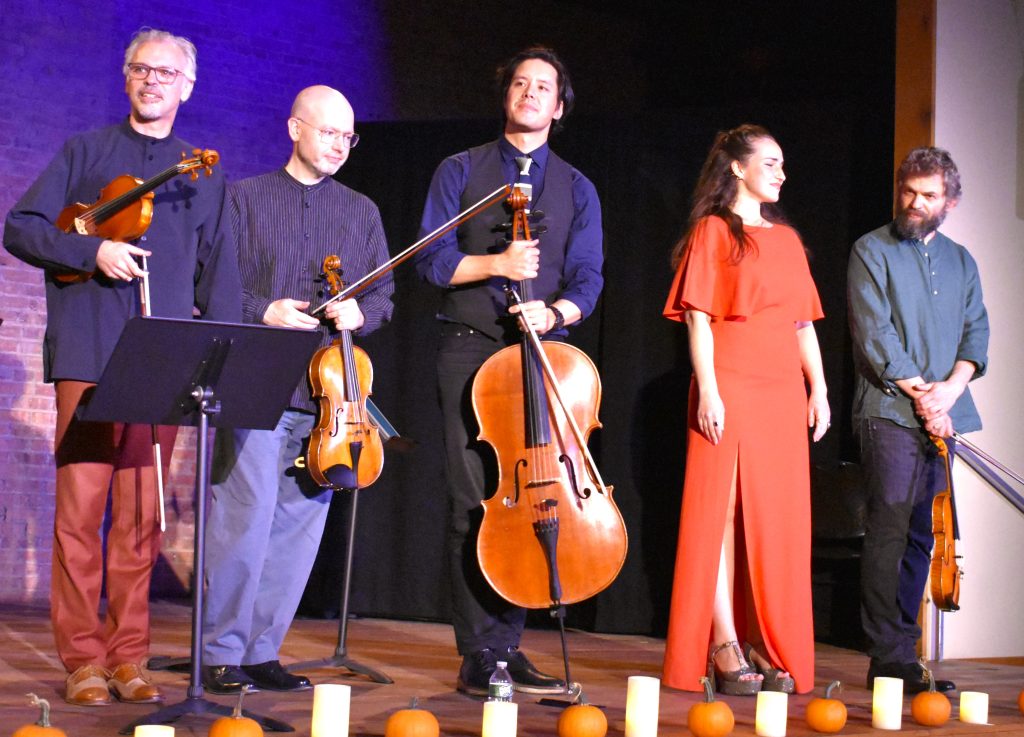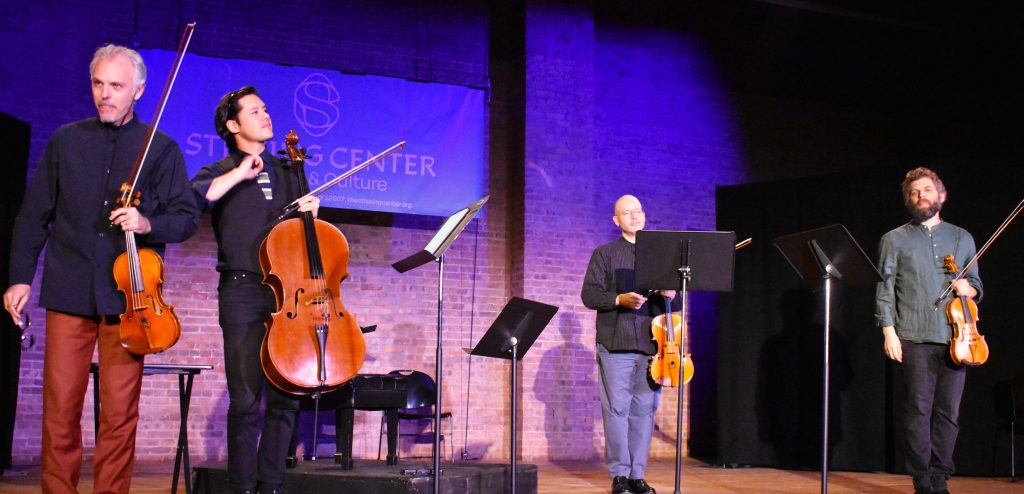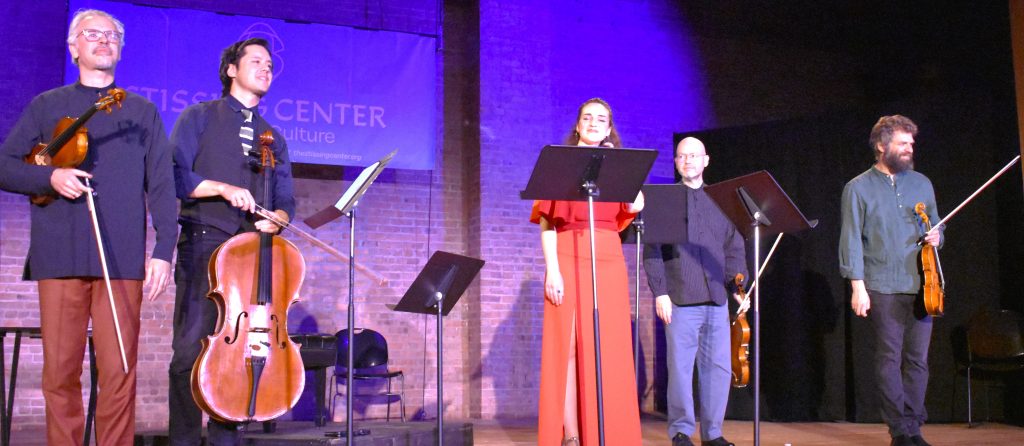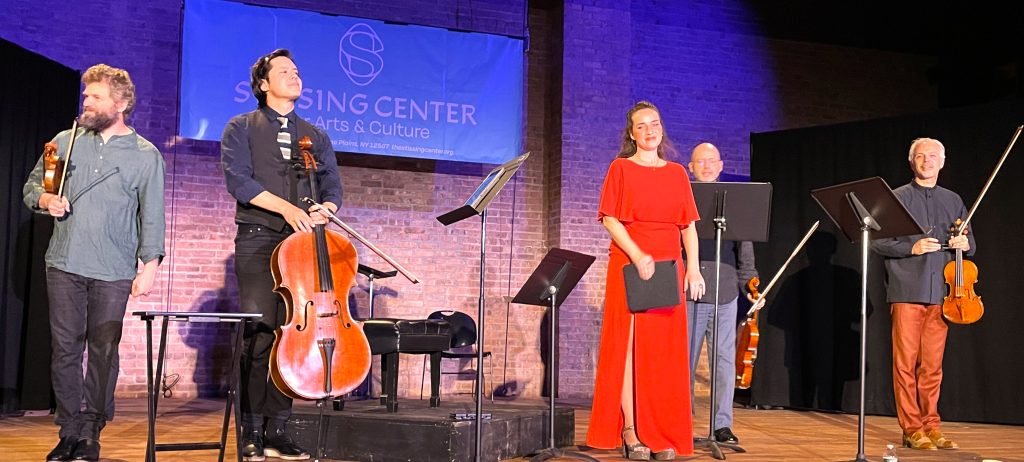
by Kevin T McEneaney
Brooklyn Rider takes its name from The Blue Rider, a surrealist European collective that published an almanac, essays, and music that offered a futuristic vision of novel aesthetics. They are intensely influenced by the atonal compositions of Arnold Schoenberg whose atonal approach offered diverse new paths to expanding the “vocabulary” of concert music.
Their program featured three recently commissioned compositions by contemporary composers and a minimalist opera with Soprano Ariadne Greif. They opened with Cinematheque by Brazilian-born American Clarice Assad, a pianist who composes music in various styles: classical, jazz, pop, and world music. Cinematheque highlighted the jumbled transitions found in film music editing which concentrates on depicting sudden emotional leaps or changes from cityscape tenements to lush forests, arguments between couples to the humor of children. The music offered layers of syncopated rhythm and abrupt harmonic shifts with climatic emotional moods and meditative ambiance. The audience is invited to let their imagination provide their own individual filmic soundscape. Sequences shuttled with tight transitions. Cellist Michael Nicolas excelled in articulating the resonance of syncopated textures.
Untitled by prolific percussionist Tyshawn Sorey offered mellow, introspective moods that contrasted sharply with the opening composition. Instead of rippling structures, he provided an atmosphere of gentle color where the viola of Nicholas Chords shimmered in an unfolding contemplative landscape that dramatized thoughtful restraint suggesting an echoing evocation of religious mysticism. Moments of unexpected silence arrive as integral to the developing future that the audience was invited to imagine. This was a satisfying entry to a world of introspective meditation.

American Studies by Gabriel Kahane delivers a sociological soundscape of multiple dictions where the super-charged dueling violins of Johnny Gandelsman and Colin Jacobsen soared in competitive fury with syncopated rhythms. Blues bleeds into the musical phrasing. Rural beauty and solitude provide contrast with the abrupt cacophony of cities. Harmonies were both lean, propulsive, and angular. This was an energetic and exciting work that put me on the edge of my seat and those singing violins still resonate in my mind.
All three of these compositions owed a debt to Arnold Schoenberg who tossed out the conventional rules of classical composition by turning to atonal music. Since Schoenberg’s work is not usually featured in the rounds of concert halls, it was a pleasant treat to hear his String Quartet No. 2 played with such intense fervor. Schoenberg often said, “I am a conservative who was forced to become a revolutionary.” The great critic Richard Taruskin in an essay once accused Schoenberg of having an “immoderate reverence for the canon,” during a rant against period performance authenticity as a futile romantic construct.
In about 1908 Schoenberg tossed out the rule of writing in a specific key as he struggled to harness atonality. During the following year, he composed his second quartet employing atonality. At this point in his life, Schoenberg loved to hang out in Vienna with assorted Expressionist painters like Gerstl or Kandinsky. This second quartet was a historic breakthrough, a landmark achievement in the history of music.
The opening Scherzo bears the words that “all is lost,” referring to Mathilde, Gerstl’s wife who had run away from her impoverished husband who could not sell his paintings. Gerstl’s shocking suicide led to the theme of how poverty and famine drive people desperate and insane. The first movement opens with lush harmonies, yet as the four movements progress the hint of atonality gradually increases in intensity as poetic yearning escalates in a gradual progression of achievement (inspired by the lyrics of the lyrics of poet Stephan George). All sting player played with magnificent unity! The final movement, “Transport,” embraces complete atonality in a free-floating ambiance as it resonates with ethereal beauty delivering one of the most memorable and haunting achievements in music as Soprano Ariadne Grieg accompanied the quartet! What a sublime ending!

The second half of the two-hour program was devoted to a new composition by violinist Colin Jacobson who introduced Chalk & Soot which was inspired by Schoenberg’s Erwartung (1909), a thirty-minute Operetta for fifteen instruments, presenting the story of a woman who discovers the dead body of her lover in a forest where she was to meet him. This is a powerful and evocative lament of hysterical grief.
Chalk & Soot offers a modern update of Schoenberg’s Operetta with current political implications, presenting the lament of a woman who has lost the rights to her own body; the man who has done this is described as a man who has no eyes, ears, or heart—he has driven the woman insane.
Ariadne sang eloquently with fierce anger at the loss of her body and country to an unfeeling narcissist and criminal. As I write the day before our election, I cannot predict if this extraordinary composition will be retained as a statement of continued protest or become a forgotten aside. I think that slight pruning of the work, which lasts for about an hour, would enhance its visceral impact.
